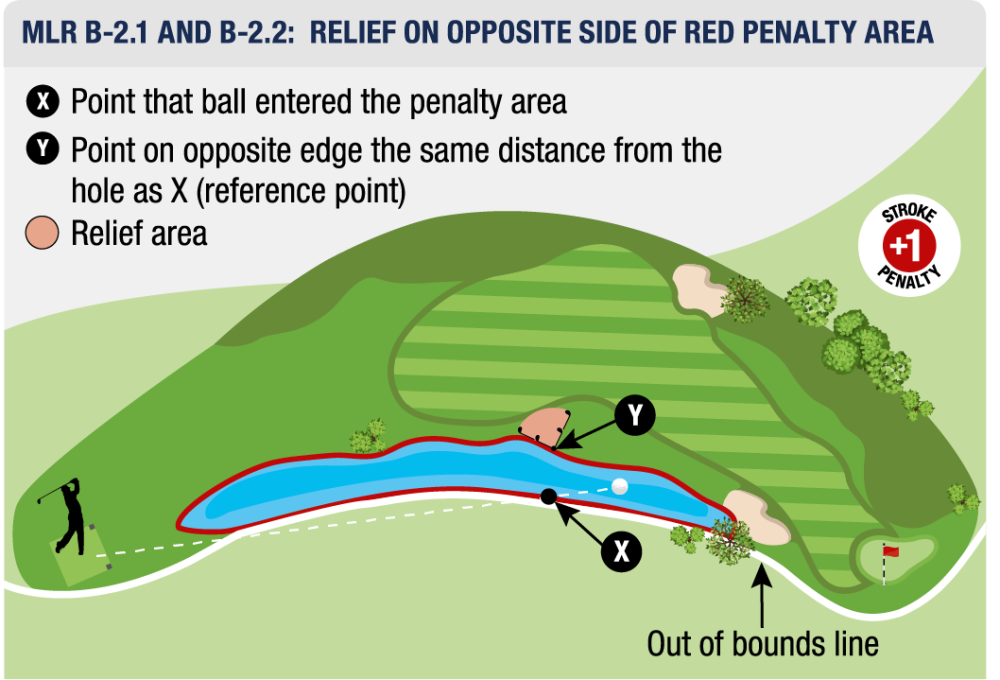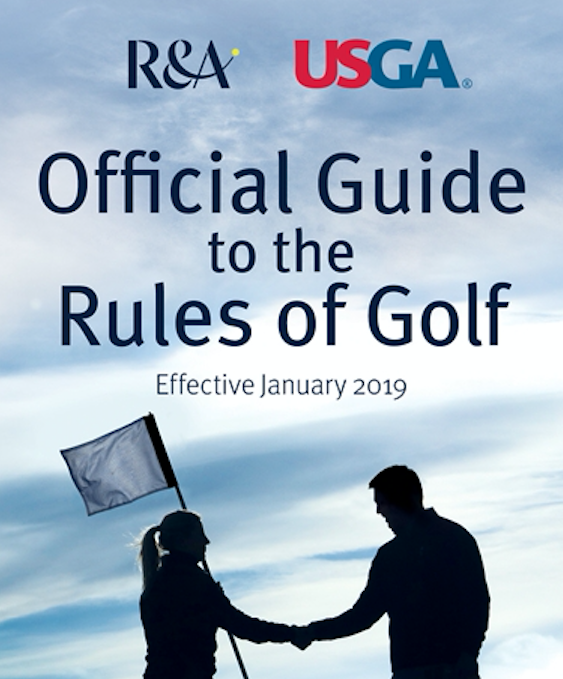B-1 Defining Penalty Areas
Purpose. There are many ways in which a Committee can define penalty areas on the course and so it is not necessary or possible to provide a complete list of Model Local Rules that can be used for this purpose.
The key is to be clear and specific when defining penalty areas in the Local Rules.
No specific Model Local Rules are included in this section given the variety of options available, but some examples are provided below:
- When playing the [specify hole number] the yellow penalty area on [specify other hole number] is to be played as a red penalty area.
- The red penalty area on [specify hole number] extends to and coincides with the out of bounds edge.
- The red penalty area on [specify hole number] defined on only one side extends to infinity.
While it is a good practice to mark the edges of penalty areas, there are times when the edge of the penalty area can be defined by language on the scorecard or Local Rules sheet.
This should only be done when there will be little confusion about where the edge of the penalty area begins, and it can be done in a consistent manner throughout the course. Some examples are:
- All desert areas are red penalty areas and the edge of the penalty area is where the grass and desert meet.
- All areas of lava are red penalty areas.
- Where an artificial wall surrounds the edge of a lake or other body of water, the penalty area is defined by the outside edge of the wall.
See Sections 2C and 5B(2) for more information on defining penalty areas.
B-2 Relief on Opposite Side of Red Penalty Area
Purpose. Rule 17.1 gives a player the option to take lateral relief or back-on-the-line relief based on where his or her ball last crossed the edge of a red penalty area. But in some cases (for example, due to the location of the red penalty area right next to a course boundary), those options may leave the player with no reasonable option other than to take stroke-and-distance relief.
A Committee can introduce a Local Rule to allow lateral relief on the opposite side of the red penalty area as an extra relief option under Rule 17.1d.
When considering a Local Rule to allow additional relief:
- The Committee should consider introducing the Local Rule in situations when a player could be seriously disadvantaged if it was not introduced. Two such examples are:
- Where a boundary coincides with the edge of a penalty area down the side of a hole such that if a ball last crossed into the penalty area on the boundary side, the player would be likely to have no realistic relief option other than to play again under stroke and distance.
- Where the layout of the penalty area is such that there could be doubt as to where the ball last crossed into the penalty area and the decision on which side of the penalty area the ball last crossed has a considerable impact on where to take relief. This applies if a relatively narrow penalty area is bounded by bushes or thick rough on one side and fairway on the other.
- It is recommended that the Committee specify the location of specific penalty areas that the Local Rule applies to, rather than applying it to all red penalty areas on the course. This Local Rule should not be used to allow a player to use this opposite side relief option to get across a red penalty area to a more favourable location than is available if only normal lateral relief under Rule 17.1d is used and available.
- It may also be desirable to mark the penalty areas where this option is available in a special way such as putting a different coloured top on any stakes where the extra option is available, and this should be stated in the Local Rule.
- Instead of using this Local Rule, the Committee may decide to put one of more dropping zones in place (see Model Local Rule E-1).
Model Local Rule B-2.1
“When a player’s ball is in a penalty area, including when it is known or virtually certain to be in a penalty area even though not found, the player may take relief using one of the options under Rule 17.1d.
Or, when the ball last crossed the edge of the red penalty area on [specify hole number and location], as an extra relief option adding one penalty stroke, the player may drop the original ball or another ball on the opposite side of the penalty area:

- Reference Point: The estimated point on the opposite edge of the penalty area that is the same distance from the hole as the estimated point where the original ball last crossed the edge of the red penalty area.
- Size of Relief Area Measured from Reference Point: Two club-lengths, but with these limits
- Limits on Location of Relief Area:
- Must not be nearer the hole than the reference point, and
- May be in any area of the course except the same penalty area, but
- If more than one area of the course is located within two club-lengths of the reference point, the ball must come to rest in the relief area in the same area of the course that the ball first touches when dropped in the relief area.
Penalty for Playing Ball from a Wrong Place in Breach of Local Rule: General Penalty Under Rule 14.7a.”
Model Local Rule B-2.2
Model Local Rule B-2.1 applies but with the following amendment to the first paragraph:
“This Local Rule applies when a player’s ball is found in or it is known or virtually certain to have come to rest in any red penalty area that coincides with a boundary of the course and the point where the ball last crossed the edge of the penalty area is on the boundary side of that penalty area.”
B-3 Provisional Ball for Ball in a Penalty Area
Purpose. Under Rule 18.3, a player is not allowed to play a ball provisionally if it is known or virtually certain that his or her ball is in a penalty area.
But in unusual cases, the size, shape or location of a penalty area may be such that:
- The player cannot see whether the ball is in the penalty area,
- It would unreasonably delay play if the player had to go forward to look for the ball before returning to play another ball under penalty of stroke and distance, and
- If the original ball is not found, it would be known or virtually certain that the ball is in the penalty area.
For such situations, to save time a Committee may choose to modify Rule 18.3:
- Rule 18.3a is modified to allow the player to play a ball provisionally under Rule 17.1d(1), Rule 17.1d(2) or, for a red penalty area, Rule 17.1d(3).
- Rules 18.3b and 18.3c are modified to state when such a provisional ball must or may be played or abandoned, as stated in the Model Local Rule.
Model Local Rule B-3
“If a player does not know whether his or her ball is in the penalty area [identify location], the player may play a provisional ball under Rule 18.3, which is modified in this way:
In playing the provisional ball, the player may use the stroke-and-distance relief option (see Rule 17.1d(1), the back-on-the-line relief option (see Rule 17.1d(2)) or, if it is a red penalty area, the lateral relief option (see Rule 17.1d(3)). If a dropping zone (see Model Local Rule E-1) is available for this penalty area, the player may also use that relief option.
Once the player has played a provisional ball under this Rule, he or she may not use any further options under Rule 17.1 in relation to the original ball.
In deciding when that provisional ball becomes the player’s ball in play or if it must or may be abandoned, Rule 18.3c(2) and 18.3c(3) apply except that:
- When Original Ball Is Found in Penalty Area Within Three-Minute Search Time. The player may choose either to:
- Continue to play the original ball as it lies in the penalty area, in which case the provisional ball must not be played. All strokes with that provisional ball before it was abandoned (including strokes made and any penalty strokes solely from playing that ball) do not count, or
- Continue to play the provisional ball in which case the original ball must not be played.
- When Original Ball Is Not Found Within Three-Minute Search Time or Is Known or Virtually Certain to Be in Penalty Area. The provisional ball becomes the player’s ball in play.
Penalty for Breach of Local Rule: General Penalty.”
B-4 Defining Open Water Course as Part of General Area
Purpose. If an open water course does not usually contain water (such as a drainage ditch or run-off area that is dry except during a rainy season), the Committee can define that area as part of the general area.
The Committee can also choose to mark such an open water course as a penalty area during times of the year when it contains water, or leave it as part of the general area, in which case any water that collects would be treated as temporary water. However, areas that would normally contain water should be marked as penalty areas throughout the year.
See Model Local Rule F-20 for when the open water course may be made a part of an abnormal course condition.
Model Local Rule B-4.1
“The [describe specific water course, e.g. ditch] at the [detail where it is located] is to be treated as part of the general area and not as a penalty area.”
Model Local Rule B-4.2
“All [describe specific types of water courses, such as concrete drainage ditches] are to be treated as part of the general area and not as a penalty area.”
B-5 Special Relief When Penalty Area Next to Bunker
Purpose. There may be particular holes where part of the edge of a red penalty area is so close to a bunker that a player taking lateral relief under Rule 17.1d(3) will need to drop a ball in the bunker.
In such a case, a Committee can choose to create an extra relief option allowing the player, for one penalty stroke, to take relief in a dropping zone positioned on the fairway side of the bunker.
Model Local Rule B-5
“This Local Rule allows the use of a dropping zone as an extra relief option when:
- A player’s ball is in the red penalty area [identify location], including when it is known or virtually certain that the ball came to rest in the penalty area, and
- The ball last crossed the edge of the red penalty area [identify start and end locations such as between two specially marked stakes].
In that case, the player may:
- Take relief under one of the options in Rule 17.1d, adding one penalty stroke , or
- As an extra option, also adding one penalty stroke , take relief by dropping a ball in and playing it from the nearest dropping zone to the point where the ball last crossed the edge of the red penalty area and that is not nearer the hole than that point.
Penalty for Playing Ball from a Wrong Place in Breach of Local Rule: General Penalty Under Rule 14.7a.”


